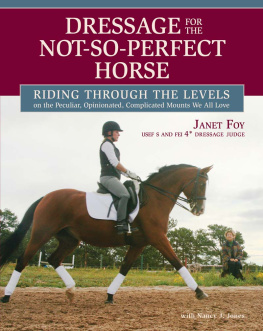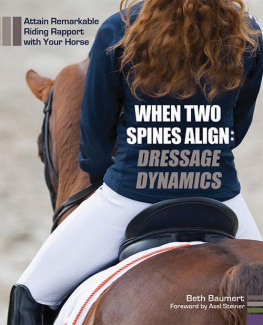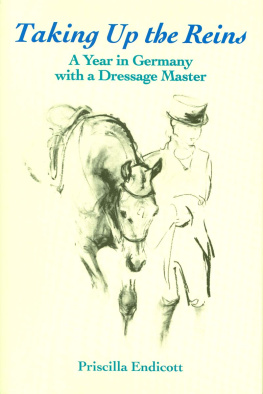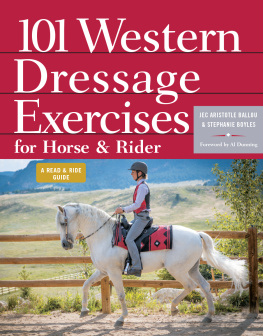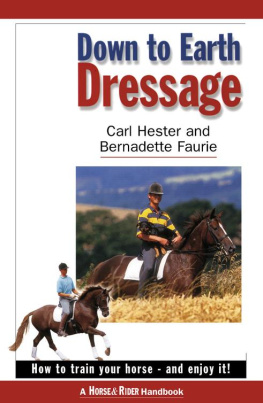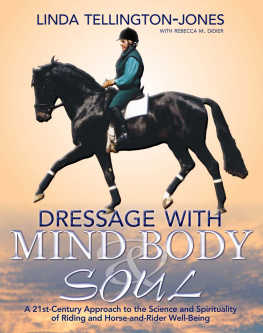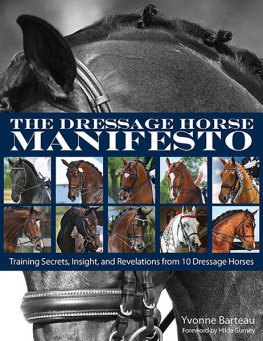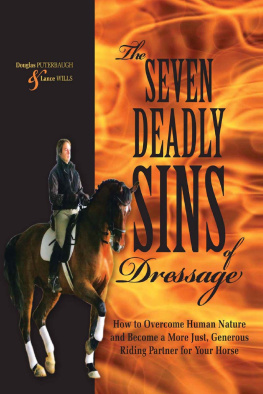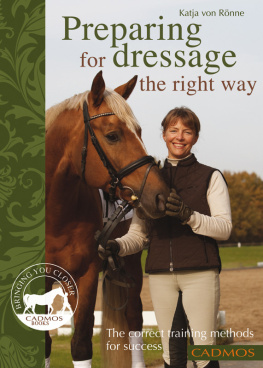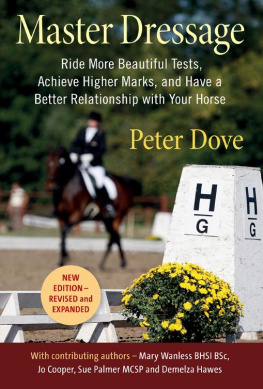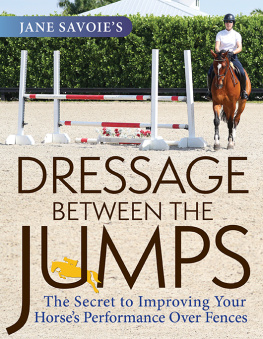DRESSAGE Q & A
with Janet Foy
ALSO BY JANET FOY
Dressage for the Not-So-Perfect Horse
DRESSAGE Q & A
with Janet Foy
Hundreds of Your
Questions Answered:
How to Ride, Train,
Compete and Love It!
JANET FOY
First published in 2015 by
Trafalgar Square Books
North Pomfret, Vermont 05053
Copyright 2015 Janet Foy
All rights reserved. No part of this book may be reproduced, by any means, without written permission of the publisher, except by a reviewer quoting brief excerpts for a review in a magazine, newspaper, or website.
Disclaimer of Liability
The author and publisher shall have neither liability nor responsibility to any person or entity with respect to any loss or damage caused or alleged to be caused directly or indirectly by the information contained in this book. While the book is as accurate as the author can make it, there may be errors, omissions, and inaccuracies.
Trafalgar Square Books encourages the use of approved safety helmets in all equestrian sports and activities.
Library of Congress Cataloging-in-Publication Data
Foy, Janet.
Dressage Q & A with Janet Foy : hundreds of your questions answered :
how to ride, train, compete, and love it! / Janet Foy.
pages cm
Includes index.
ISBN 978-1-57076-674-9
1. Dressage. I. Title.
SF309.5.F67 2015
798.2'3--dc23
2015013560
Illustrations by Nicole Cotton Ackerman
Cover design by RM Didier
Book design by Brian Prendergast (www.brianpgraphics.com)
Typeset in Adobe Raleigh and Adobe Myriad Pro
Printed in United States of America
10 9 8 7 6 5 4 3 2 1
Dedication
To all of my Facebook friends and clinic students who helpfully submitted questions and their Aha! moments.
May your journey with your best friend be an educational and fulfilling one. Happy Riding!
CONTENTS
Acknowledgments
I would like to thank all of the wonderful editors at Trafalgar Square Books for their help, guidance, and occasional reprimand! You helped make my journey easier!
INTRODUCTION
W hen the topic of this book was discussed, I thought it would be a great way to answer all the questions I have from my dressage friends. I have arranged it in two sections:
). Questions can be found at the end of each of these chapters, too, and I do my best to clarify difficult and confusing issues in my answers.
All along I thought it would be best to organize the questions Ive received along the lines of the dressage Training Pyramid. So in . This is helpful in several ways: First, it gives me a logical place to put each question and answer (Q & A), and second, it gives all of you a review of the stages of the Training Pyramid and why it is important that you follow this scale of training with your horse. I found it very interesting to see on which topic the majority of the questions I received were based. Not surprisingly, it was contact! I have always felt that this is the hardest part of dressage to teach because it is about feel. Feel is hard to teach, and most people dont have it by nature, so it must be learned. During a lesson, think about how many times you hear, Do you feel that?
Following discussion of the Pyramid, youll find chapters on movements and showing. Throughout, I often reference my first book Dressage for the Not-So-Perfect Horse. Please know this is because I go into great detail when it comes to how to actually perform movements in that book, an effort I do not repeat here.
It is my hope this book will help your dressage journey: the problems and solutions (Q & As) address often-asked questions about dressage, and the commonsense approaches I offer should make your learning easier and more fun. Lastly, by sharing many riders Aha! moments in sidebars throughout, I hope you wont have to wait so long to have your own similar breakthroughs!
PART 1
Commonsense Dressage
CHAPTER ONE
Dressage Terms Made Simple
I think a large part of the problem of educating dressage riders in the United States is the language. We are not a country with horse words. In German, there are many dressage words that take a whole sentence in English to explain. And, many of the terms that have been translated from German to English are confusingwith the English not properly describing what they mean. Often, I hear this called dressage babble.
I think we need to speak in a more simple language. I am sure some of my dressage-word definitions will offend the highly educated in biomechanics, so please pardon my attempt to not get complicated. So with the theme of lets keep it simple, here is my list of definitions, presented alphabetically, with a dash of common sense:
Accuracy
Being accurate in the arena when riding figures is one of the most importantand frequently ignoredconcepts in dressage. You need to learn to love geometry; know how many meters are between each letter; plot the figures you are riding on a graph. At all levels, the ability to ride accurate figures and completely use the corners of the arena will tell you a lot about the control you have over your horse. Dont lose stupid points for inaccuracy. Accuracy is perhaps the easiest dressage concept to practice at home, then improve at a show.
Activity
Activity refers to the bending of the horses hind legs while they are in the air. An active hind leg will come up and down in the air and show good articulation of the joints. This type of hind leg may or may not help with engagement (see ). Think of a Hackney.
Against the Bit
When the horse is against the bit, he pulls down or pushes into the bit by using his under-neck muscles or stiffening his poll. Visually, you will see the horses under-neck muscles bulging.
Aids
The rider has three aids in dressage: Your legs, your hands, and your seat. Thats it. Simple.
Balance
Balance is an important term. It refers to the balance of the horse in relationship to the dressage levels. For Training and First Level, the horse should be carrying the same amount of weight on all four legs. In other words, this horse is in a level balance. In a level balance, his hind legs are pushing him forward over the ground. At Second Level, the balance should show a tendency to stay uphill. His hind legs now carry more weight than the front legs. Due to this carrying effect (called engagement), he will thrust up in the air before he moves forward over the ground. Think of a spring coiling and uncoiling. The balance requirement and the strength of the carrying power of the hind legs increases as the horse moves up the levels.
Basics
The basics are made up from elements on the Training Pyramid. When your basics are correct, your horse can perform all three gaits in the correct rhythm. Correct basics improve the quality of the gaits: the horse will have a supple back and stretch elastically into an even contact, and you will have a forward-thinking horse. You will be able to ride him on the line of travel and with these elements in place, balance will improve toward


